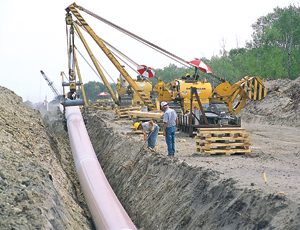A day after receiving a Presidential Permit, contractors for Enbridge Energy Partners LP, Houston, began work on the U.S. portion of a 992-mile pipeline. The Alberta Clipper will move 450,000 bbl per day from Canada’s oil sands in Alberta to Superior, Wis., with a planned capacity of up to 800,000 bpd.

More than 3,000 U.S. workers will be employed on the 326 miles of 36-in. pipeline, five tanks, three pumping stations and a companion 188-mile-long, 20-in. pipeline to carry diluents to Canada, says Jim Crawford, director of engineering and construction for Enbridge. The U.S. segment of the $3.3-billion pipeline is expected to cost about $1.2 billion.
Global Pipeline Partners, a partnership of three pipeline contractors—including Michels Corp., Brownsville, Wis.; Precision Pipeline LLC, Eau Claire, Wis.; and U.S. Pipeline Inc., Houston—is expected to complete construction of the pipeline by the middle of 2010. Gulf Interstate Engineering, Houston, assisted Enbridge’s staff with engineering. Construction on the Canadian portion, beginning in Hardisty, Alberta, started in 2008 and is expected to be completed by the end of the year. Willbros Group Inc., Houston, is the contractor for the Canadian portion. Australia-based WorleyParsons performed engineering services.
About 40% of the pipeline will run through wetlands in Minnesota, adding a unique challenge to the job, Crawford says. To work more effectively in the wet areas, crews will wait until winter and build the pipeline using ice and frost roads.
The U.S. State Dept. issued the permit over objections of environmentalists, saying, “Approval of the permit sends a positive economic signal in a difficult economic period about the future reliability and availability of a portion of U.S.’ energy imports, and in the immediate term, this shovel-ready project will provide construction jobs for workers in the U.S.”

Post a comment to this article
Report Abusive Comment